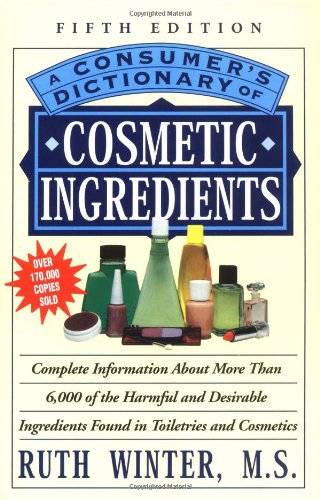
Sinossi
Containing more than six thousand entries, a helpful resource of information on the ingredients in cosmetics reports on the origins, function, and possible health effects of specific preservatives, acids, buffers, humectants, colorings, flavorings, and processing agents. Original.
Le informazioni nella sezione "Riassunto" possono far riferimento a edizioni diverse di questo titolo.
Informazioni sull?autore
Ruth Winter, M.S., is an award-winning science writer who is nationally known for her many books and for her magazine articles in Family Circle, Woman's Day, Omni, and Reader's Digest. She is also the author of A Consumer's Dictionary of Food Additives and A Consumer's Dictionary of Medicines: Prescription, Over-the-Counter, Homeopathic, and Herbal.
Dal risvolto di copertina interno
ition of this classic guide, first published in 1978, continues the tradition of being the most up-to-date, complete, and trusted reference for taking the guesswork out of choosing safe and effective cosmetics and toiletries.
The more than 6,000 entries include 1,400 newly developed chemicals (along with hundreds more whose names have been changed by the manufacturers since the last edition of this book was published in 1994). Virtually every chemical found in toiletries and cosmetics, from body and face creams to toothpaste, hand lotion, shaving cream, shampoo, soap, perfume, and makeup, is evaluated, including those ingredients marketed as being all natural, for children, and for people of color. The book's alphabetical arrangement makes it easy to look up the ingredients in the products you use.
With more substances than ever in products we use every day--and with the continuing deregulation of the cosmetics industry--this book is more indispensable than ever.
Le informazioni nella sezione "Su questo libro" possono far riferimento a edizioni diverse di questo titolo.
Altre edizioni note dello stesso titolo
Risultati della ricerca per A Consumers Dictionary of Cosmetic Ingredients
A Consumer's Dictionary of Cosmetic Ingredients
Da: World of Books (was SecondSale), Montgomery, IL, U.S.A.
Condizione: Very Good. Item in very good condition! Textbooks may not include supplemental items i.e. CDs, access codes etc. Codice articolo 00074399044
Compra usato
Quantità: 2 disponibili
A Consumer's Dictionary of Cosmetic Ingredients
Da: World of Books (was SecondSale), Montgomery, IL, U.S.A.
Condizione: Good. Item in very good condition! Textbooks may not include supplemental items i.e. CDs, access codes etc. Codice articolo 00074913541
Compra usato
Quantità: 2 disponibili
A Consumer's Dictionary of Cosmetic Ingredients
Da: World of Books (was SecondSale), Montgomery, IL, U.S.A.
Condizione: Acceptable. Item in acceptable condition! Textbooks may not include supplemental items i.e. CDs, access codes etc. Codice articolo 00080006921
Compra usato
Quantità: 1 disponibili
A Consumer's Dictionary of Cosmetic Ingredients
Da: BooksRun, Philadelphia, PA, U.S.A.
Paperback. Condizione: Good. 5th. It's a preowned item in good condition and includes all the pages. It may have some general signs of wear and tear, such as markings, highlighting, slight damage to the cover, minimal wear to the binding, etc., but they will not affect the overall reading experience. Codice articolo 0609803670-11-1
Compra usato
Quantità: 1 disponibili
A Consumer's Dictionary of Cosmetic Ingredients
Da: Wonder Book, Frederick, MD, U.S.A.
Condizione: Good. Good condition. 5th edition. A copy that has been read but remains intact. May contain markings such as bookplates, stamps, limited notes and highlighting, or a few light stains. Codice articolo D02K-00130
Compra usato
Quantità: 1 disponibili
A Consumer's Dictionary of Cosmetic Ingredients
Da: ThriftBooks-Phoenix, Phoenix, AZ, U.S.A.
Paperback. Condizione: Very Good. No Jacket. May have limited writing in cover pages. Pages are unmarked. ~ ThriftBooks: Read More, Spend Less. Codice articolo G0609803670I4N00
Compra usato
Quantità: 1 disponibili
A Consumer's Dictionary of Cosmetic Ingredients
Da: ThriftBooks-Dallas, Dallas, TX, U.S.A.
Paperback. Condizione: Very Good. No Jacket. May have limited writing in cover pages. Pages are unmarked. ~ ThriftBooks: Read More, Spend Less. Codice articolo G0609803670I4N00
Compra usato
Quantità: 1 disponibili
A Consumer's Dictionary of Cosmetic Ingredients : Fifth Edition
Da: Better World Books, Mishawaka, IN, U.S.A.
Condizione: Very Good. Used book that is in excellent condition. May show signs of wear or have minor defects. Codice articolo GRP76409476
Compra usato
Quantità: 1 disponibili
A Consumer's Dictionary of Cosmetic Ingredients : Fifth Edition
Da: Better World Books: West, Reno, NV, U.S.A.
Condizione: Very Good. Former library book; may include library markings. Used book that is in excellent condition. May show signs of wear or have minor defects. Codice articolo GRP63634170
Compra usato
Quantità: 1 disponibili
A Consumer's Dictionary of Cosmetic Ingredients : Fifth Edition
Da: Better World Books: West, Reno, NV, U.S.A.
Condizione: Good. Used book that is in clean, average condition without any missing pages. Codice articolo 4349324-75
Compra usato
Quantità: 1 disponibili

